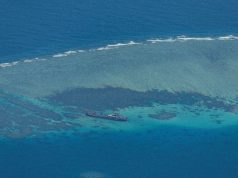
MANILA – Pending a detailed investigation into why its bombs fell short of the enemy and landed near a building housing friendly troops – killing two and wounding 11 others – all South Korean-made FA-50 “Fighting Eagle” jet aircraft conducting close-air support missions in Marawi City will be temporarily grounded.
This was bared by Armed Forces of the Philippines (AFP) spokesperson Brig. Gen. Restituto Padilla in a briefing Thursday.
“The FA-50 will momentarily be pulled out from deployment as close-air (support) aircraft until the investigation has been conducted and once we have ascertained whatever reason was behind one of the bombs falling short of target,” he added.
The AFP, through the Air Force, has 12 FA-50 jet fighters currently in service. The aircraft were acquired in 2015.
Deliveries started December of that year and were completed in 2017.
However, Padilla clarified that use of other AFP air assets like the SIAI-Marchetti SF-260s, Rockwell OV-10 “Bronco” and various types of attack helicopters will continue.
The above-mentioned aircraft, which is capable of flying up to Mach 1.5 speed, has successfully performed 70 close-air support missions prior Wednesday’s incident.
“Again, as I mentioned, the high success rate of the aircraft in previous missions is indicative of its efficiency and effectivity as a platform that supports our troops. However the accident yesterday (July 12) will require us to look closely and what caused the failure of one of the bombs and once we determine that remedial measures will have to be undertaken to correct it,” Padilla pointed out.
The two FA-50s were conducting missions to destroy Maute Group positions in Marawi City when one of its bombs landed 250 meters short of the intended target.
The ensuing blast rocked a nearby building housing friendly troops, tearing large chunks of the structure and hurling it on the sheltering soldiers, killing two and wounding 11 others.
Padilla said he has no idea of the exact payload or weight of the bomb that accidentally hit the building sheltering government troops.
He added only one bomb out of the four dropped by the FA-50s went short and awry.
“If it’s any cause of consolation the 11 wounded are all ambulatory and now out of danger and on the road to recovery. However, our two men who died in that area are unfortunately an additional two to the number of casualties that have been building up recently. So we have to bring the remains of our heroes to their families and that’s what were trying to do right now, and we pass all our condolences to the families who lost their loved ones again,” the AFP spokesperson stressed.
“So suffice it to say there was a bomb run or an airstrike that was conducted, one bomb not hitting the target, three others were proximate to the target and were efficiently employed, and except that one bomb, we would like to find out what caused it to fall short of target,” Padilla added.
And speaking as a veteran pilot, the AFP spokesperson said accidentally hitting friendly troops is a combat aviator’s worse nightmare.
“These kinds of incident will occur in the battle because of the complexity of the environment, the fog of war, the lack of communication and what have you, so in this case we have no reason to say that it was the fault of the pilot yet until after we have done the investigation,” he added.
Click and watch this video report:









